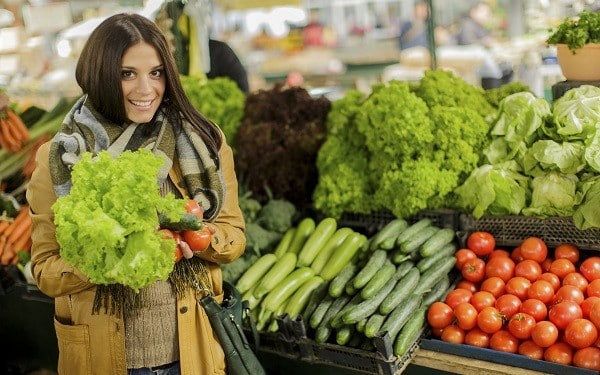
What to Eat this Season – Winter’s Top 10 Veggies
Don’t let the chilly weather keep you from getting your necessary veggies! Look for winter produce at local farmers markets for the best flavor (and in many cases, the greatest value) in season. Most of San Diego’s farmers markets are open throughout the winter months, making it easy for us to enjoy fresh and flavorful produce year-round.
Here’s a list of some of our favorite seasonal winter vegetables:
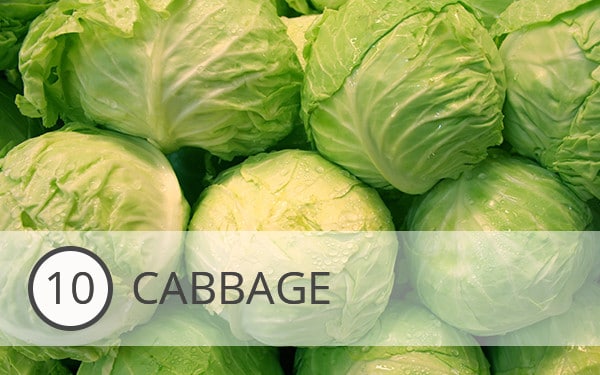
Cabbage comes in on our list at number ten, because it’s not only a great source of fiber, but it’s also loaded with potent vitamins and antioxidants. Like broccoli and brussels sprouts, cabbage is a valuable source of glucosinolates, a substance that has been attributed to reducing the risk of some types of cancers. At just about 22 calories per cup, you can also eat just about as much of it as you want!
How to enjoy: Studies have suggested that steaming is probably the best way to maximize the health benefits of the glucosinolates found in cabbage. Don’t have a vegetable steamer? Try this method for steaming cabbage on the stove.
Recipes to try:
- Asian Chicken Salad, from The World’s Healthiest Foods
- Stir-fried Tofu with Cabbage, Carrots and Red Peppers, by Martha Rose Shulman
- Garlic Rubbed Roasted Cabbage Steaks, by Lori Burley
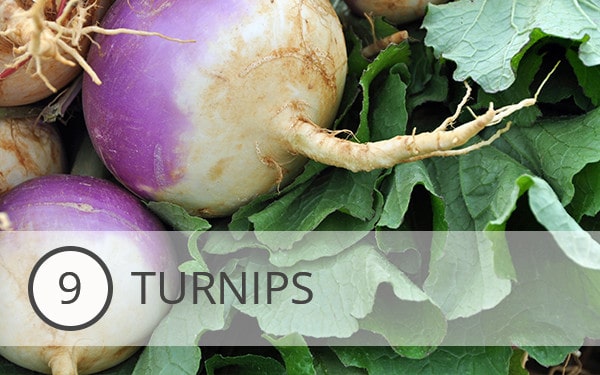
Turnips are winter root vegetables that are in peak season from October to February. The turnip’s root is a great source of vitamin C, and the greens are also a good source of vitamin A, folate, and calcium.
How to enjoy: Turnips have a characteristically sharp flavor, but they are very versatile. Turnips can be eaten raw, or served roasted, sautéed, mashed, or pureed. Turnip leaves may also be eaten raw, boiled, steamed, or stir-fried.
Recipes to try:
- Roasted Turnips, by Molly Watson
- Potato and Turnip Cakes, from Martha Stewart Living
- Indian Mashed Turnips, from Fearless Kitchen
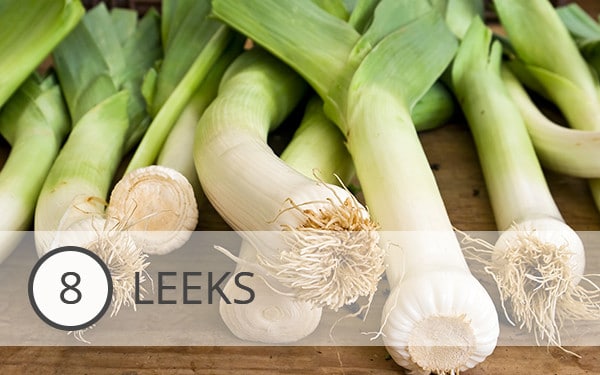
Leeks are a member of the onion family and are related to scallions, shallots, and chives. Leeks may be harvested year-round, but are most flavorful during the fall and winter months. They’re low in calories, saturated fat, cholesterol, and sodium, and high in fiber and calcium.
How to enjoy: Leeks are perhaps best known as the flavorful base of some of our favorite soups, dips, and savory pies. When preparing, use only the white and lightest-green portion and make sure to clean thoroughly between layers. Here are some tips on how to properly clean leeks from Simply Recipes.
Recipes to try:
- Foil Baked Salmon with Leeks and Bell Peppers, from Simply Recipes
- Potato and Leek Soup, by Robert Irvine of the Food Network
- Leek & Lemon Linguine, from Eating Well
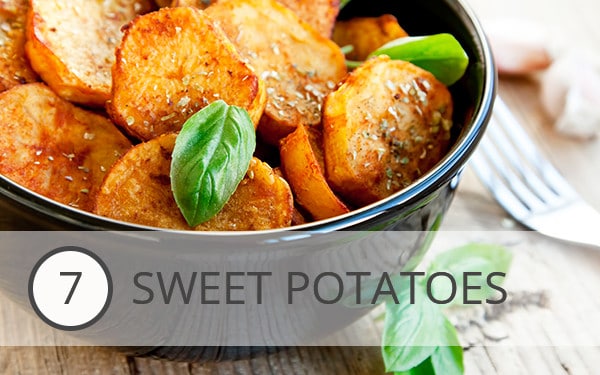
Sweet potatoes are large, starchy, sweet-tasting root vegetables that work exceptionally well in hearty winter recipes. Not only are they readily available and inexpensive, but they also have many important health benefits. They’re particularly high in vitamin B6, vitamin C, vitamin D, iron, magnesium, and potassium.
How to enjoy: Sweet potatoes are so versatile, you can prepare them just about any way. Try them baked, grilled, roasted, pureed, or steamed.
Recipes to try:
- Savory Sweet Potato Fries, by Carolyn Vaught
- Creamy Carrot and Sweet Potato Soup, from My Recipes
- Slow-Cooker Sweet Potato and Lentil Soup, from Food Network
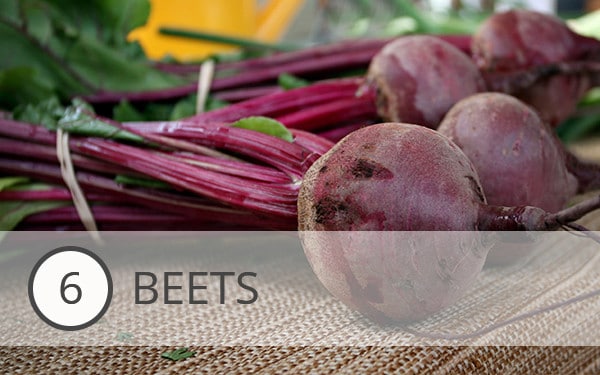
Beets are an excellent source of energy and are high in many vitamins and minerals such as potassium, magnesium, fiber, and vitamins A, B, and C. Beets have also been shown to have many liver-health benefits, as well as to help lower levels of harmful triglycerides in the blood, and lower blood pressure.
How to enjoy: We all know that beets are great in salads and soups, but what about smoothies? If you’re new to juicing or vegetable smoothies, give beets a try. Their high sugar content makes them an easy supplement.
Recipes to try:
- Roasted Beet Salad with Pea Shoots & Chevre, from Adventures in Cooking
- Beet and Feta Burgers, from Green Kitchen Stories
- Beet “Pasta,” by A Beautiful Mess
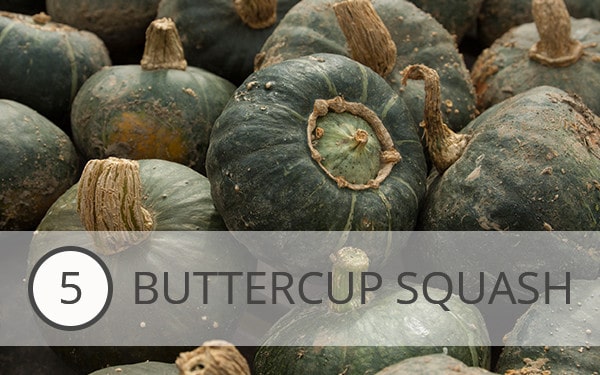
Buttercup squash is a popular winter squash that has a creamy orange flesh that is typically sweeter than other winter varieties. A half cup serving of buttercup squash contains less than 50 calories and is loaded with calciu, magnesium, potassium, and vitamins A, B, and C.
How to enjoy: Buttercup squash works well with a wide variety of seasonings and is typically used in soups, lasagna, casseroles, and desserts. Steaming and baking are preferred cooking methods, because they tend to bring out the sweetness of the squash while retaining moisture.
Recipes to try:
- Creamy Buttercup Squash Risotto, by Stephanie Laidlaw
- Curried Buttercup Squash and Apple Soup, from Martha Stewart Living
- Buttercup Pasta with Spinach and Sweet Onions, from Natural Noshing
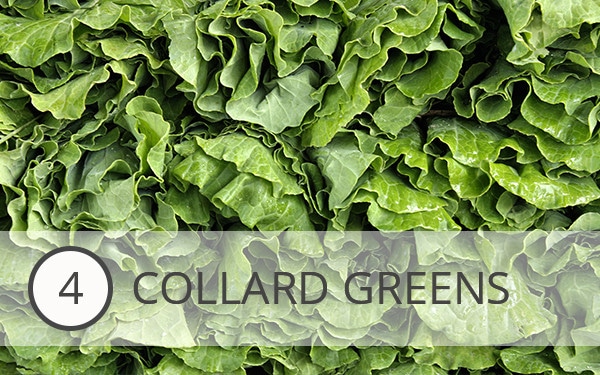
Collard greens, known for their large, dark green colored leaves, are a staple vegetable in southern American diets . They’re an excellent source of vitamin K, with about 858% of your daily recommended dose in just one cup! Collard greens may be enjoyed year-round, but are most flavorful in the winter months.
How to enjoy: The healthiest way to prepare collard greens is to steam them. The key is to not overcook so that the leaves retain their color and nutritional value. Try this simple method for steaming collard greens (it works for Kale too!)
Recipes to try:
- 5-Minute Collard Greens, from the World’s Healthiest Foods
- Stuffed Collard Greens, from Martha Stewart Living
- Garlicky Collard Greens, from the Vegetarian Times
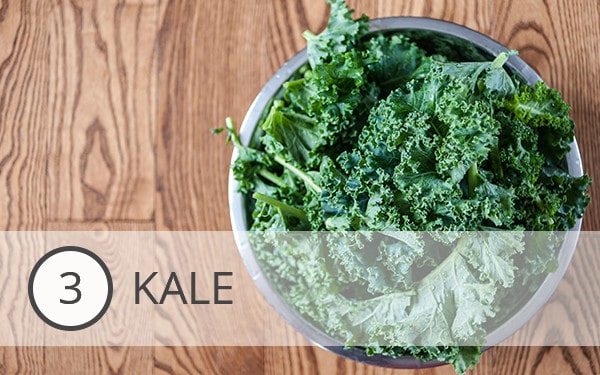
Kale is one of the healthiest and most nutritious foods on the planet, which is great because it’s also the most trendy veggie right now. Kale is a leafy, dark green vegetable that is loaded with essential vitamins A, C, and K. It’s also an excellent source of cancer-fighting antioxidants, protein, potassium, and iron.
How to enjoy: Kale is best as the base of salads, blended in smoothies, or sautéed in a pan. New to smoothies? Try these five favorites!
Recipes to try:
- Kale Guacamole, by Kelly Morrison of Honest Cooking
- Kale Smoothie with Pineapple and Banana, from Real Simple
- Kale Salad with Grilled Artichokes, from Cooking Light
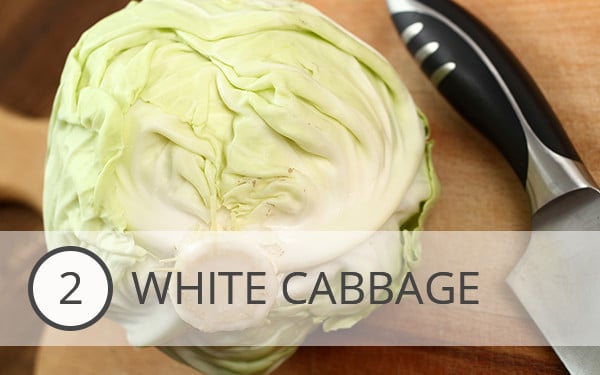
White cabbage is a very light-colored form of green cabbage that works well in hearty winter meals. In addition to being a good source of vitamin K, cabbage is also rich in antioxidants and anti-inflammatory nutrients. Studies have shown white cabbage to support a healthy digestive tract and cardiovascular system.
How to enjoy: Cabbage is known for having some of the best cholesterol-lowering benefits, especially when steamed or sautéed.
Recipes to try:
- Braised White Cabbage with Bacon & Thyme, by Jamie Oliver
- White Beans and Cabbage, from the Steamy Kitchen
- Braised White Cabbage, from Food.com
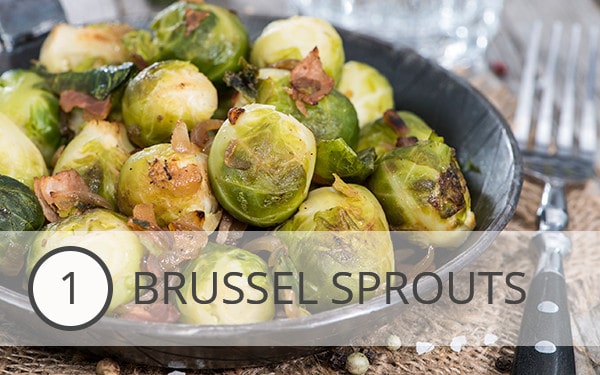
Brussels sprouts come in on our list at number one because they’re just so tasty and nutritious! Did you know that brussels sprouts are actually a type of cabbage? They also have all of the same great health benefits of cabbage while being in a fun bite-size.
How to enjoy: Brussels sprouts may be enjoyed raw but have the most health benefits when steamed or sautéed. Our favorite method for preparing brussels sprouts is to cut them in half and saute them in a pan with a little olive oil, salt, and pepper. Try this simple method.
Recipes to try:
- Roasted Brussels Sprouts, by Ina Garten of the Food Network
- Thyme-Braised Brussels Sprouts, from Eating Well
- Brussels Sprouts with Toasted Almonds, from Simply Recipes

Join our Senior Wellness Society for the latest news on Medicare and tips for healthy living in San Diego!
Sign up now ›Are you looking for specialized medical care in San Diego?
Our directory has more than 850 doctors in San Diego County of various specialties who are available to help you.
Find a doctor